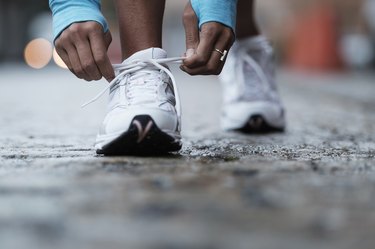
Walking is a simple yet effective exercise. After all, it's free (you don't need expensive equipment or a trainer) and it's an excellent way to improve your heart health and burn some calories.
Truly, all you have to do is get outside (or on a treadmill) and put one foot in front of the other!
Video of the Day
Video of the Day
If you specifically want to walk to lose weight, though, you may need to create a plan — like walking 2 miles per day — along with other strategies, like getting proper nutrition, sleep and strength training.
Here, learn how much weight you can lose walking 2 miles per day along with tips to make your 2-mile walk as effective as possible.
Warning
Always talk to your doctor before beginning a new exercise routine so they can make sure it's the right approach for you based on your health status and medical history.
How Much Weight Can You Lose From Walking 2 Miles Per Day?
Physical activity of any kind can support your weight-loss efforts, and that includes walking. But exactly how much weight you'll lose by walking 2 miles per day depends on several different factors, including your current weight and fitness level, your health status, the intensity of your walk and even your genetics.
With that said, one August 2017 study in the Journal of Nutrition may be able to give us a rough idea: It included two groups of people who were put on an energy-restricted diet. One group walked three hours a week (the equivalent of walking for 30 minutes six days per week, which is about the same as walking 2 miles per day), and the other did not exercise. The study found the people who walked three hours a week had a significant boost in weight loss, shedding about 19 pounds by the end of the 12 weeks.
For those people, walking about 2 miles almost every day and cutting calories helped them lose an average of about 1.5 pounds per week, which is considered a healthy rate of weight loss, according to the Centers for Disease Control and Prevention (CDC).
Keep in mind that this is just an average, though, so actual weight loss looked different from person to person. While some people might lose about 20 pounds in three months by walking 2 miles every day and cutting calories, others may lose more or less weight.
Unfortunately, there's no hard-and-fast formula for determining exactly how much weight you'll lose walking 2 miles per day.
Generally speaking, though, you will lose weight walking 2 miles per day if you stay consistent and incorporate other healthy lifestyle changes along the way.
How Many Calories Does Walking 2 Miles Burn?
When it comes to calories burned in a 2-mile walk, it mostly depends on your walking pace and weight.
In terms of pace: Walking at 2 miles per hour (mph) is considered a casual pace, while 3 mph is a moderate pace and 4 mph is a very brisk pace. Here's how long it takes to walk 2 miles at these different speeds:
- 2 mph pace: 30 minutes per mile; 60 minutes to walk 2 miles
- 3 mph pace: 20 minutes per mile; 40 minutes to walk 2 miles
- 4 mph pace: 15 minutes per mile; 30 minutes to walk 2 miles
With that in mind, the table below can give you a general sense of how many calories you'd burn walking 2 miles based on your speed and weight.
Calories Burned Walking 2 Miles
Weight | 2 mph pace | 3 mph pace | 4 mph pace |
|---|---|---|---|
150 lbs | 136 calories | 149 calories | 170 calories |
175 lbs | 158 calories | 174 calories | 198 calories |
200 lbs | 181 calories | 199 calories | 226 calories |
225 lbs | 204 calories | 224 calories | 255 calories |
250 lbs | 226 calories | 249 calories | 283 calories |
300 lbs | 272 calories | 299 calories | 340 calories |
If you want to know exactly how many calories you burn each 2-mile walk, use a walking app on your smartphone or fitness tracker to track your progress. This can also help you estimate how much weight you'll lose in the long-term.
Tip
If you're aiming to walk for other health benefits, it's probably not necessary to walk 2 miles every single day. Instead, try to get 150 to 300 minutes of walking each week, per the CDC. And instead of hitting 2 miles each day, spread your weekly cardio exercise across the week and walk for time, not distance.
How to Lose Weight by Walking 2 Miles a Day
If you want to lose weight by walking 2 miles every day, you have to find ways to make the walk more challenging, which will help you burn more calories.
You'll also have to consider your diet and other lifestyle factors that affect weight — like stress, sleep, hydration, medication side effects and underlying health conditions.
Here are some tips to help you get started losing weight by walking 2 miles per day:
1. Stay Consistent
It should come as no surprise that staying consistent with your walking routine — that is, walking the full 2 miles every day — will help you achieve your goals more quickly and efficiently.
2. Use a GPS App to Track Your Walk
Often, walking or fitness apps on your phone will have a GPS feature to help you track how far you've walked. This will help you make sure you're hitting the 2 mile-mark each day.
A GPS tracker could also help you determine the route you take during your walk.
3. Choose a Challenging (but Motivating) Location
Finding a location where you can walk uphill or up stairs can add an extra challenge, which can help increase weight loss. You could also walk on the treadmill with it set at an incline. Or, if you're having a hard time staying motivated, choose a place to walk that most inspires you, like a park or a running track.
Just keep in mind you may have to walk these routes multiple times to hit your 2-mile mark.
4. Wear Proper Walking Shoes
Look for a pair of supportive walking sneakers that offer cushion just above your heel to avoid blistering. You should also find a pair that doesn't slip off while you're walking — they shouldn't feel too tight or too loose.
Make sure you're also replacing your shoes every 300 miles or so (or every year, whichever comes first).
5. Up Your Pace
The faster you walk, the higher your heart rate and the more calories you burn. And the more calories burned, the greater likelihood for weight loss over a sustained period of time.
The average walking speed is about 3.5 mph for moderate intensity (which would take you about 35 minutes to walk 2 miles), but if you're just starting out, you can start anywhere below that, per the CDC.
6. Add Weights
To up the ante, try wearing wrist or ankle weights on your walk. Or wear a backpack or weighted vest to up the resistance.
This added weight will make the walk more challenging, thus increasing your chances of weight loss.
7. Add Challenges Throughout
Adding in circuit-training exercises — like push-ups, squats or lunges — during your walks could help increase your calorie burn. (You could also try a specific walking workout.)
You can start out by doing this at the halfway mark (1 mile), and then keep adding more challenges as your fitness level increases.
8. Walk With a Friend
Having an exercise buddy — a friend or loved one with similar fitness goals — can help you stay motivated and help keep you accountable toward your goals.
9. Incorporate Walking Into Everyday Tasks
If you find you don't have the time or energy to walk 2 miles all at once, you can add steps to your day by walking on your lunch break, walking to run errands or grab coffee in your neighborhood or parking farther away from your location to walk more.
This can help tack on some extra steps and calorie burn if committing to 2 miles at once doesn't feel doable.
10. Take a Look at Your Diet
In terms of weight loss, fad diets and rigorous exercise routines can help you lose weight quickly, but they'll ultimately do more harm than good.
That said, creating a realistic and healthy calorie deficit each day through your diet can help you lose weight no matter how much you're walking.
To do this, you'll need to find out how many calories you're eating each day to maintain your current weight, with the help of a food diary or app. Once you know your maintenance calorie amount, try cutting about 500 calories from that number for slow-and-steady (read: healthy) weight loss, per the Mayo Clinic.
In addition to finding your calorie goal, it's important to prioritize eating whole foods, including:
- Fruits
- Vegetables
- Complex carbohydrates like brown rice, oatmeal and sweet potatoes
- Lean protein like chicken, fish and low-fat dairy
Limiting highly processed foods like chips and sweets (which are typically high in calories and low in nutrients) can also help you hit your desired daily calorie deficit.
11. Get Enough Sleep
Sleep and weight loss are tightly linked. Not getting enough shut-eye (that's seven to nine hours per night for healthy adults, according to the CDC), can rev up your hunger, decrease your energy for exercise and even change the way your body stores fat.
12. Switch Up Your Exercise
If walking 2 miles per day feels a little repetitive after a while, try another exercise like strength training, yoga or swimming to help improve your body's fat-to-muscle ratio.
Other Health Benefits of Walking 2 Miles per Day
There are other health benefits of walking that go beyond losing weight. These can include:
1. Lower BMI and Waist Circumference
A January 2017 study in the International Journal of Obesity found that people who walk more have a lower body mass index (BMI). People in the study who walked more than 15,000 steps a day had a healthy BMI, which offers a decreased risk of obesity.
Additionally, walking can reduce waist circumference, which is associated with reduced risk of heart disease and type 2 diabetes, per the American Heart Association.
In other words, walking 2 miles a day could help you lose belly fat. Indeed, a September 2014 study in the Journal of Exercise Nutrition & Biochemistry concluded that walking is a safe and effective way to reduce abdominal obesity (aka belly fat) and insulin resistance in women with obesity.
2. Lower Glucose, Cholesterol and Blood Pressure
An April 2013 study in JAMA found that people who walk for exercise have a 12 percent reduced risk of type 2 diabetes, and a 7 percent reduced risk of high cholesterol and high blood pressure.
3. Improved Cardiovascular Health
Walking is a cardio exercise that strengthens the heart muscle. Those with heart disease are often recommended a daily walking regimen by their doctors to help improve their circulation, increase aerobic capacity of the heart and reduce blood pressure. It's also a safe exercise option if you're currently dealing with heart issues, per the Harvard T.H. Chan School of Public Health.
4. Improved Sleep
An October 2019 study in Sleep Health suggests that folks who take a brisk walk during the day have higher-quality sleep at night.
Exercising can also help you fall asleep faster at night and can improve sleep duration and quality, per Johns Hopkins Medicine.
5. Improved Balance and Posture
Walking helps build lower-body strength, an important element of good balance, per Harvard Health Publishing.
Poor balance can lead to falls and serious injuries. But a combination of walking and balance exercises can help prevent falls, especially in older adults, per Harvard Health Publishing.
6. Improved Mood
A December 2020 study in the International Journal of Environmental Research and Public Health found that people who engaged in regular walks had better emotional health than those who did not exercise regularly.
Aerobic exercise (like walking) has also been found to relieve symptoms of depression and anxiety, per the Mayo Clinic.
7. Improved Lung Function
Both aerobic activities like walking and muscle-strengthening exercises can benefit your lungs. Walking, in particular, can help strengthen your lungs and help them and your heart work more efficiently, per the American Lung Association.
8. Less Chronic Pain
Physical activity like walking can lower the risk for developing chronic pain and assist in managing existing chronic pain from conditions like fibromyalgia and neck/shoulder pain, per Utah State University.
The Bottom Line
You can lose weight walking 2 miles per day, but you will see greater results in combination with other lifestyle changes such as eating a balanced diet, getting proper sleep, reducing stress and managing underlying health conditions that could lead to weight gain.
How much weight you lose walking 2 miles will vary based on your current weight and fitness level, walking pace, metabolism and other genetic factors.
Overall, it's important to be patient when it comes to weight loss. Focus on building sustainable, long-term habits. You may not see results overnight, but it will happen if you remain consistent and keep leveling up your 2-mile walk to make it more challenging.
- Mayo Clinic: "Counting Calories: Get Back to Weight-Loss Basics"
- UC Berkeley: "Exercise: Starting a Walking Program"
- CDC: "Walking"
- Academy of Nutrition and Dietetics: "Fiber"
- Mayo Clinic: "Nutrition Rules That Will Fuel Your Workout"
- American Council on Exercise: "Tools & Calculators"
- JAMA: "Walking Versus Running for Hypertension, Cholesterol, and Diabetes Mellitus Risk Reduction"
- Journal of Nutrition: "Moderate Walking Enhances the Effects of an Energy-Restricted Diet on Fat Mass Loss and Serum Insulin in Overweight and Obese Adults in a 12-Week Randomized Controlled Trial"
- Sleep Health: "Walk to a better night of sleep: testing the relationship between physical activity and sleep"
- Harvard Health Publishing: "Improve Your Balance By Walking"
- International Journal of Environmental Research and Public Health: "Exploring the Relationship between Walking and Emotional Health in China"
- American Lung Association: "Exercise and Lung Health"
- Utah State University: "Exercise and Chronic Pain"
- International Journal of Obesity: "Time spent in sedentary posture is associated with waist circumference and cardiovascular risk"
- American Heart Association: "Waist size predicts heart attacks better than BMI, especially in women"
- Keisan Casio: Walking Calorie Calculator
- Journal of Exercise Nutrition & Biochemistry: "Effect of walking exercise on abdominal fat, insulin resistance and serum cytokines in obese women"
- Harvard Health Publishing: "Revitalize Your Walking Routine"
- CDC: "Measuring Physical Activity"
- Harvard T.H. Chan School of Public Health: "Walking"
- Johns Hopkins Medicine: "Exercising for Better Sleep"
- Mayo Clinic: "Depression and anxiety: Exercise Eases Symptoms"
- Centers for Disease Control and Prevention: "Losing Weight"
- Centers for Disease Control and Prevention: "How Much Sleep Do I Need?"

